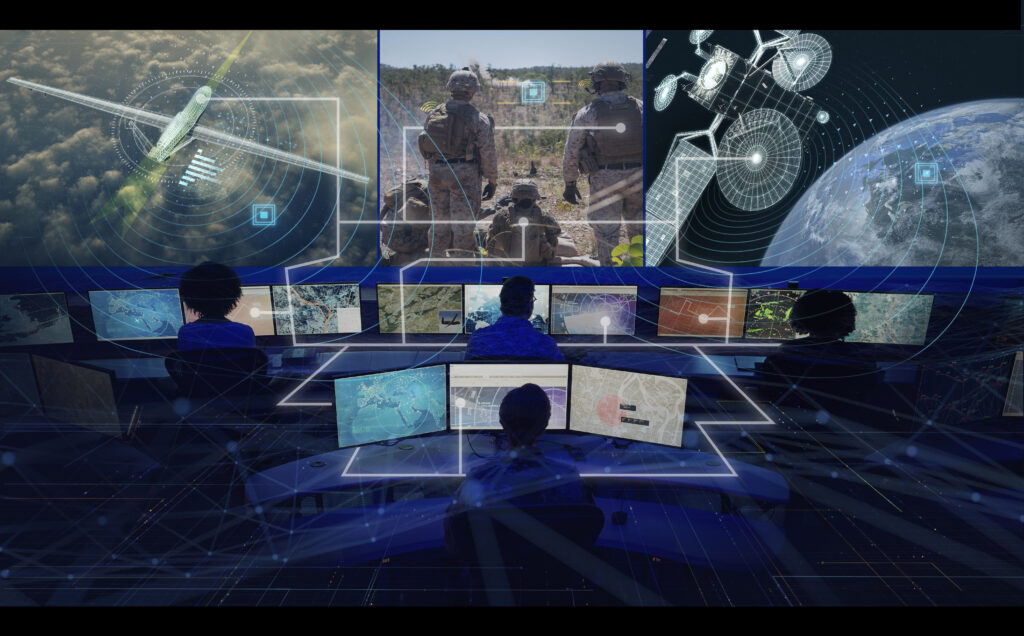
JADC2 illustration (Northrop Grumman)
WASHINGTON: The Defense Department is “weeks away” from finalizing the implementation plan for its Joint All Domain Command and Control (JADC2) concept, J6 Deputy Director and Cross-Functional Chair Brig. Gen. Robert Parker said today.
The implementation plan represents the start of the next key phase in the DoD’s journey to move JADC2 from concept to operational technology.
The implementation plan will be classified, but Parker hinted at some of what it will entail, including objectives, tasks, transactions, and milestones, as well as service contributions and combatant command efforts.
Parker told the audience at the Defense News Conference the implementation plan will cover “6+1 minimum viable products,” including DevSecOps, transport (think networks), cloud, and identity and credential access management (ICAM).
One point garnering “a lot of discussion” right now, Parker said, is the networks. The DoD is exploring federated networks as a way to tie all the services together. The challenge? Figuring out zero-trust security, Parker said. “That one is still out there for discussion,” he added.
The need to solve that and many other complex issues came into stark relief last month as the US withdrew from Afghanistan, which Parker said showed that the DoD has “grossly underestimated [JADC2],” particularly in terms of “authoritative data sources” that can be drawn from to support operations.
“We’ve become lazy” in populating data, Parker said, before offering a common saying around DoD these days: Data is the ammunition for future fights. “If that’s the case, then you probably want to know where your data — your ammunition — is,” Parker noted.
He said the two big takeaways for JADC2 that should be drawn from the Afghanistan withdrawal are these: First, DoD “need[s] persistent ability with tools and processes to have that data there,” and second, the human resources necessary to make JADC2 work are “pretty intensive.”
The looming implementation plan follows Defense Secretary Lloyd Austin’s June signing of the JADC2 strategy. Since then, Parker said JADC2 teams have spent the summer identifying capability gaps and refining a reference architecture, which is now in its third version.
The reference architecture has received “positive feedback from industry,” Raj Iyer, US Army chief information officer, said today, speaking on the same panel as Parker.
Once the implementation plan is finalized, DoD will stand up two initial operating capabilities (IOCs) within 90 days, Parker said. He did not specify the IOCs, but he noted they’re “looking at” how to use the Pentagon’s Joint Artificial Intelligence Center’s (JAIC) Joint Common Foundation, although he offered no specifics.
Parker said the JADC2 teams are also “very excited” about the new Joint Warfighting Cloud Capability (JWCC), a multi-cloud environment that was unveiled by DoD CIO John Sherman in July as the replacement for the nixed Joint Enterprise Defense Infrastructure (JEDI). JWCC is unlikely to be one of the IOCs because the request for proposals will not be released until mid-October, with an initial set of contract awards expected in April 2022.
Overall, Parker judged that DoD has “been able to make a lot of progress” on JADC2 in recent months, but he also cautioned it will require “tremendous adjustments across the department and joint force.”
Iyer noted the Army is “looking at [JADC2] through a much bigger lens than just IT.”
“IT is not the end all. [The] focus is on a more holistic digital transformation journey,” he said. That’s why the service established the Army Enterprise Digital Strategy, which is focused on the data, networks, and integration of new tech.
The Army “fully realize[s] that any future fight will be a joint fight,” Iyer said. “Our mindset needs to change.”
He added, “Data interoperability and cybersecurity cannot be afterthoughts.”
Later in the discussion, Iyer made light of the intense collaboration, debates, and discussions among the services and joint staff involved with JADC2, noting, “Joint always seems fun until we get into decisions about who governs this.”
Striking a humble tone in the face of this massively complex task, Parker and Iyer repeatedly referred to the JADC2 work as a “campaign of learning.”






















